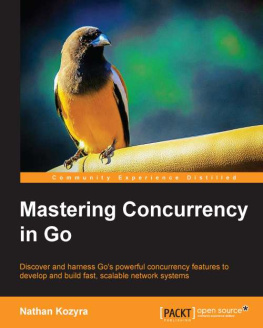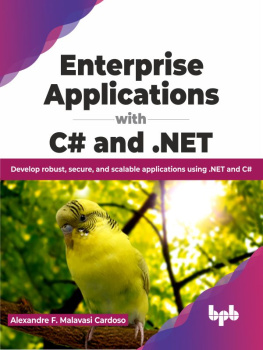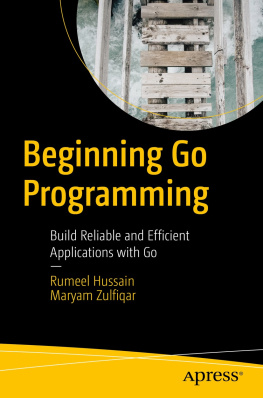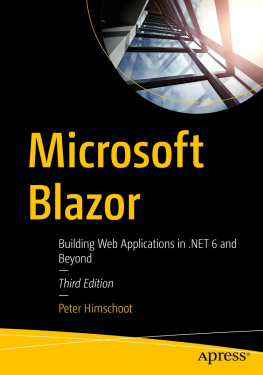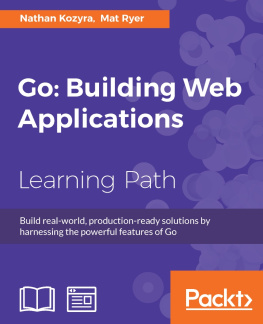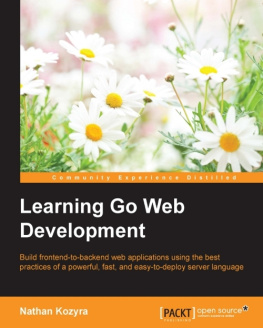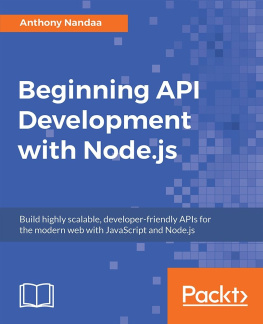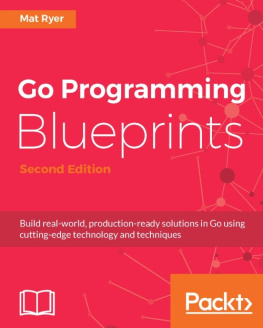Nathan Kozyra - Go: Building Web Applications
Here you can read online Nathan Kozyra - Go: Building Web Applications full text of the book (entire story) in english for free. Download pdf and epub, get meaning, cover and reviews about this ebook. year: 2016, publisher: Packt Publishing, genre: Home and family. Description of the work, (preface) as well as reviews are available. Best literature library LitArk.com created for fans of good reading and offers a wide selection of genres:
Romance novel
Science fiction
Adventure
Detective
Science
History
Home and family
Prose
Art
Politics
Computer
Non-fiction
Religion
Business
Children
Humor
Choose a favorite category and find really read worthwhile books. Enjoy immersion in the world of imagination, feel the emotions of the characters or learn something new for yourself, make an fascinating discovery.
- Book:Go: Building Web Applications
- Author:
- Publisher:Packt Publishing
- Genre:
- Year:2016
- Rating:4 / 5
- Favourites:Add to favourites
- Your mark:
Go: Building Web Applications: summary, description and annotation
We offer to read an annotation, description, summary or preface (depends on what the author of the book "Go: Building Web Applications" wrote himself). If you haven't found the necessary information about the book — write in the comments, we will try to find it.
Build real-world, production-ready solutions by harnessing the powerful features of Go
About This Book- An easy-to-follow guide that provides everything a developer needs to know to build end-to-end web applications in Go
- Write interesting and clever, but simple code, and learn skills and techniques that are directly transferable to your own projects
- A practical approach to utilize application scaffolding to design highly scalable programs that are deeply rooted in go routines and channels
This book is intended for developers who are new to Go, but have previous experience of building web applications and APIs.
What You Will Learn- Build a fully featured REST API to enable client-side single page apps
- Utilize TLS to build reliable and secure sites
- Learn to apply the nuances of the Go language to implement a wide range of start-up quality projects
- Create websites and data services capable of massive scale using Gos net/http package, exploring RESTful patterns as well as low-latency WebSocket APIs
- Interact with a variety of remote web services to consume capabilities ranging from authentication and authorization to a fully functioning thesaurus
- Explore the core syntaxes and language features that enable concurrency in Go
- Understand when and where to use concurrency to keep data consistent and applications non-blocking, responsive, and reliable
- Utilize advanced concurrency patterns and best practices to stay low-level without compromising the simplicity of Go itself
Go is an open source programming language that makes it easy to build simple, reliable, and efficient software. It is a statically typed language with syntax loosely derived from that of C, adding garbage collection, type safety, some dynamic-typing capabilities, additional built-in types such as variable-length arrays and key-value maps, and a large standard library.
This course starts with a walkthrough of the topics most critical to anyone building a new web application. Whether its keeping your application secure, connecting to your database, enabling token-based authentication, or utilizing logic-less templates, this course has you covered.
Scale, performance, and high availability lie at the heart of the projects, and the lessons learned throughout this course will arm you with everything you need to build world-class solutions. It will also take you through the history of concurrency, how Go utilizes it, how Go differs from other languages, and the features and structures of Gos concurrency core. It will make you feel comfortable designing a safe, data-consistent, and high-performance concurrent application in Go.
This course is an invaluable resource to help you understand Gos powerful features to build simple, reliable, secure, and efficient web applications.
Style and approachThis course is a step-by-step guide, which starts off with the basics of go programming to build web applications and will gradually move on to cover intermediate and advanced topics. You will be going through this smooth transition by building interesting projects along with the authors, discussing significant options, and decisions at each stage, while keeping the programs lean, uncluttered, and as simple as possible.
Nathan Kozyra: author's other books
Who wrote Go: Building Web Applications? Find out the surname, the name of the author of the book and a list of all author's works by series.



